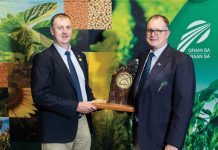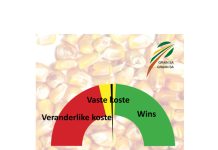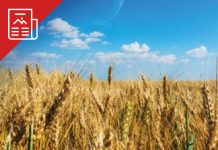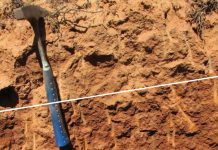When a specific body of soil is classified, the properties thereof may be easily communicated. Also, the properties thereof may be interpreted, after which the suitability of this particular body of soil may be evaluated for a specific soil usage.
In the previous article of this series, the groups of soil in which the soil formation processes were dominated by the topsoil, were discussed. In this article, we will discuss the groups of soil in which the formation processes were dominated by the subsoil.
Subsoil horizons
Diagnostic subsoil horizons naturally occur below a topsoil horizon. They are classified as B, C, E, or R master horizons. In Soil classification: A Taxonomic System for South Africa, 25 subsoil horizons are acknowledged as diagnostic (diagnostic refers here to the acknowledgement thereof in the identification of the soil types).
In the majority of cases, one or more forms of accumulation or enrichment are the dominant processes, with redistribution of iron in particular being an example of secondary process. The processes are pertinently driven by a single factor or a combination of the soil formation factors.
Soil types
When a soil profile is seen from top to bottom, characteristic horizons may be identified. The specific sequence of horizons is not coincidental, but the existence thereof is pertinently driven by the soil formation factors and processes. A specific sequence from top to bottom gives an indication of a specific soil type. Soil classification: A Taxonomic System for South Africa, acknowledges 73 (74 in Part 24) specific horizon combinations as soil types. The first number of soil groups (according to Fey, 2010) with an orthic topsoil, are now discussed (Table 1).
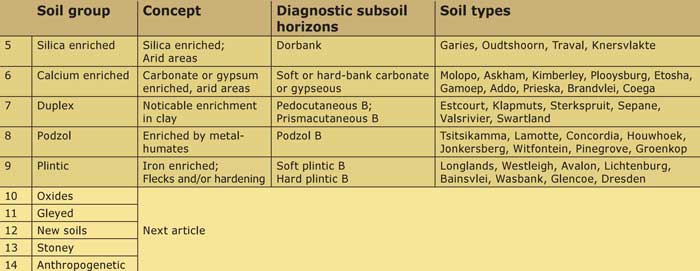
Soil group 5: Silica enriched soils
All the soils in this group have silica cemented subsoils and are described as dorbank. They may be found in the dry areas of the Western Cape, Southern Cape and Eastern Cape.
- The dominant process is eluviation (leaching) of silica from the uppermost soil horizons and accumulation thereof in the deeper soil layers (Figure 1). Silica is only slightly soluble under high pH conditions. The process is probably very slow because these soils do form in the drier areas. The formation of dorbank probably took hundreds of years.
- Dorbank is not limited to certain positions in the landscape, but mainly occurs on the plains. It looks like “normal” soil, but is exceptionally hard due to the silica that “cemented” with the soils in which it formed, to form a hard bank in the soil. Consequently, dorbank often hardened, to the extent that plant roots cannot penetrate it. It is also often impervious to water. Some of the dorbank soils have a high sodium content.
- Because soil with dorbank is usually shallow, the water retention ability thereof is limited. Furthermore, it also occurs in the arid areas, where the climate itself is limiting. Due to the probability of high levels of sodium, some of the soil is also limiting.
- Because these soils are so hard, they can continue to exist in the landscape as relic. In some extreme cases, it can even restrict the erosion of the landscape.
- These soils can be highly productive where the dorbank is broken up and irrigated (for example, along the Olifants River in the Western Cape).
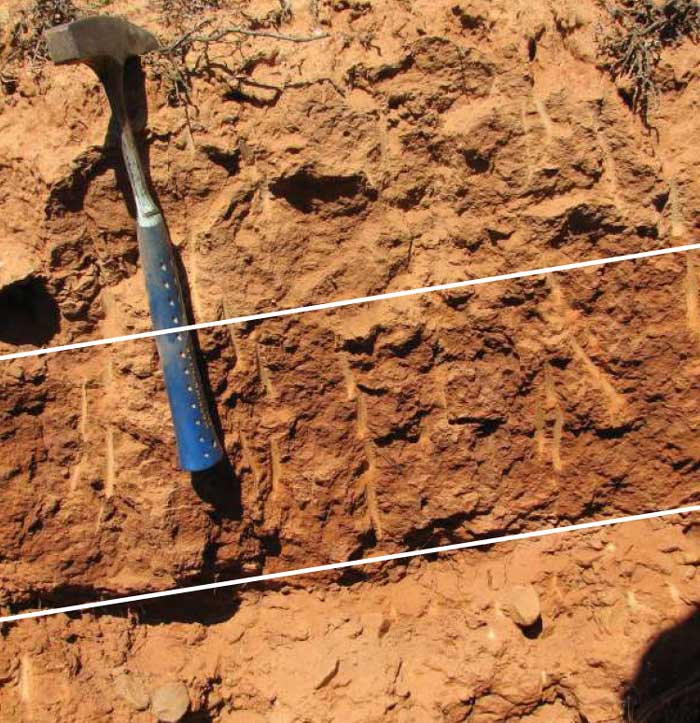
Soil group 6: calcium enriched soils
- The dominant process is the accumulation of calcium carbonate, and often also magnesium carbonate, in the soil to precipitate as calcrete in the deeper layers (Figure 2). It occurs in particular in the drier areas of South Africa. Silica also often dissolves due to the high pH and then precipitates together with the lime to form a very hard silcrete.
- Lime soils have a very high base status (Usually 100%) and a pH(water) in the lime layers of about 8,0. It is rich in calcium from the calcium carbonate and, where it also contains magnesium carbonate, it is also rich in magnesium. Soft carbonate has a very high water retention ability and is a suitable medium for plant roots to grow in. However, hard-bank carbonate is root restrictive and also often water restrictive.
- Soils with soft carbonate horizons are suitable for crop production, provided that the potential root depth is adequate. They may also be used for irrigation, but must be carefully investigated for drainage before development. Hard-bank carbonates and especially those with silcrete, may be broken with rippers in order to improve root depth and drainage.
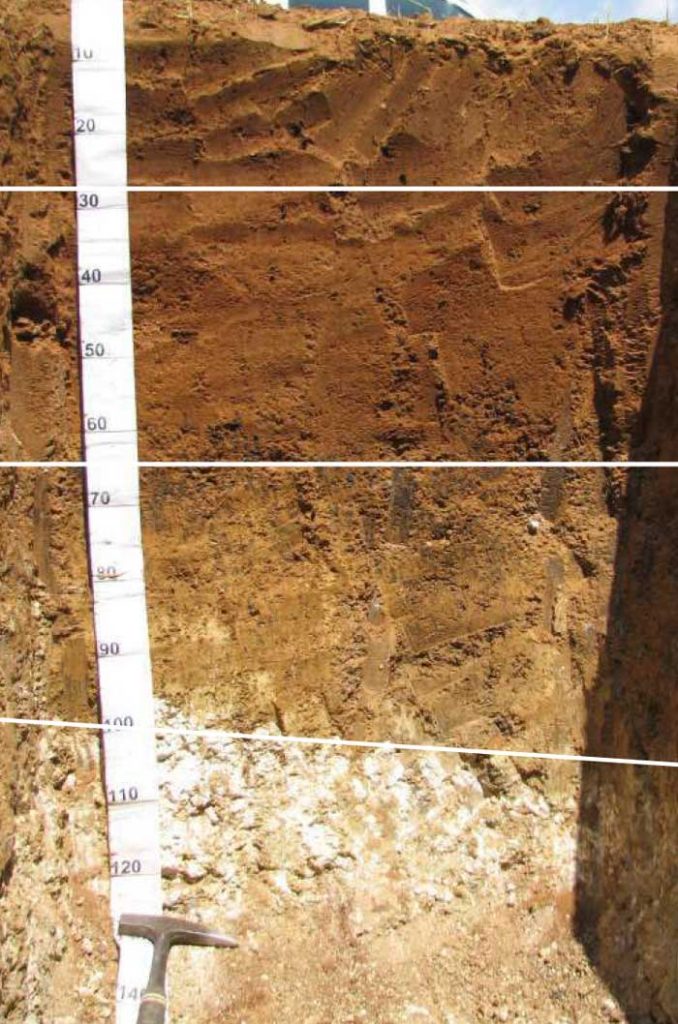
Soil group 7: Duplex soils
The dominant process is enrichment with clay from the overlying horizons. The transition from the overlying horizon to the subsoil is usually clear or abrupt (very sharp). This may often be ascribed to the fact that the sandy topsoil is deposited on top of the clayey subsoil. Sodium and magnesium often play a role in dispersion of the clay in the topsoil and, where applicable, the E horizon, after which it is leached to the subsoil and accumulates there (Figure 3). Duplex soil is mainly found in the lower parts of the landscape, but not restricted to them. It is common in the sub-humid and semi-arid areas of South Africa.
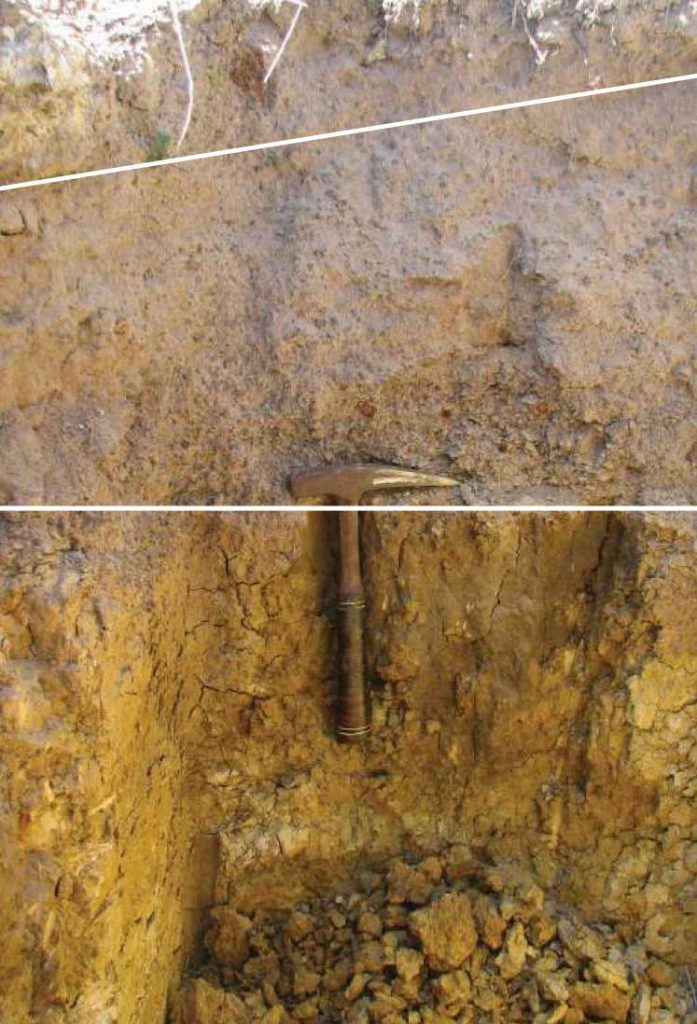
- The clay enriched subsoil has a high clay content, and 2:1 clay minerals of the smectite dominate the clay fraction, allowing the soil to swell and shrink when wetted and dried out again. The subsoil soil has a very strongly developed pedocutaneous or prismacutaneous structure. The CEC is high and the base state is usually 100%. The sodium and magnesium cause unfavourable hydraulic properties. They cause the soil to seal at the surface thus further restricting water penetration. Due to the abrupt transition to the B horizon, the topsoil becomes very wet and, if not stabilised, becomes subject to water erosion (also as a result of the high sodium content which promotes dispersion).
- Duplex soils are usually not suitable for cash crop production or irrigation, due to their hydraulic problems. Infiltration is poor, internal drainage is slow and external drainage is limited. Their best land usage is natural grassland, or as permanent planted grazing when it has already been tilled.
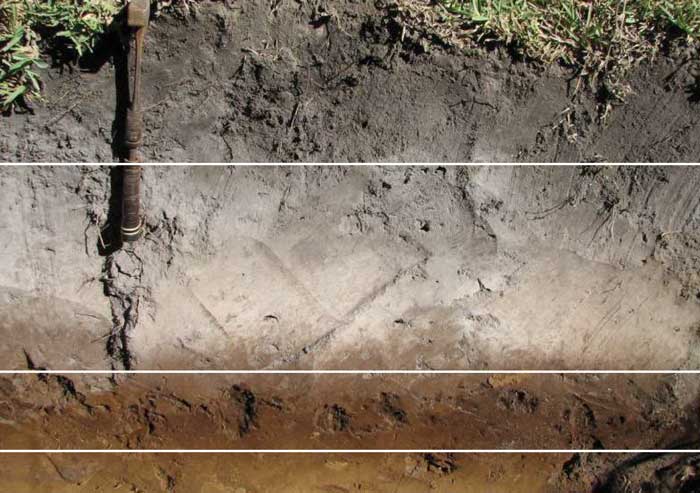
Soil group 8: Podzol soils
- Podzol soils develop in sandy soils developing out of quartzite and/or sandstone and beneath scrub growth in the high rainfall areas of the Western and eastern Cape. Under these highly acidic and high rainfall conditions, organic material leaches downwards in the profile where there is little clay to hold the humus. It accumulates lower down in the profile where the humus binds with iron and aluminium to form metal-humus complexes (Figure 4). It then precipitates there as a humus-rich, darkened horizon in the profile.
- The CEC is low due to the sandy nature of the soil. It is poorly buffered, which results in the pH of the soil being extremely low and the soil then becomes highly acidic. The base saturation is low because the cations leach out.
- Soil acidity, low CEC, low fertility and poor provision of basic cations (Ca2+, Mg2+ and K+) are the worst problems in the use of podzol soils. The sandy nature of the soils in which they form, also has a low water retention and they are sensitive to compaction. Deep application of lime and mixing are usually necessary get the soil into a productive condition. The pH of the podzol horizon is usually better and it contains large quantities of humus, thus improving the fertility of that layer. It also goes hand in hand with water table soils and should be investigated carefully so as to apply the correct manipulation.
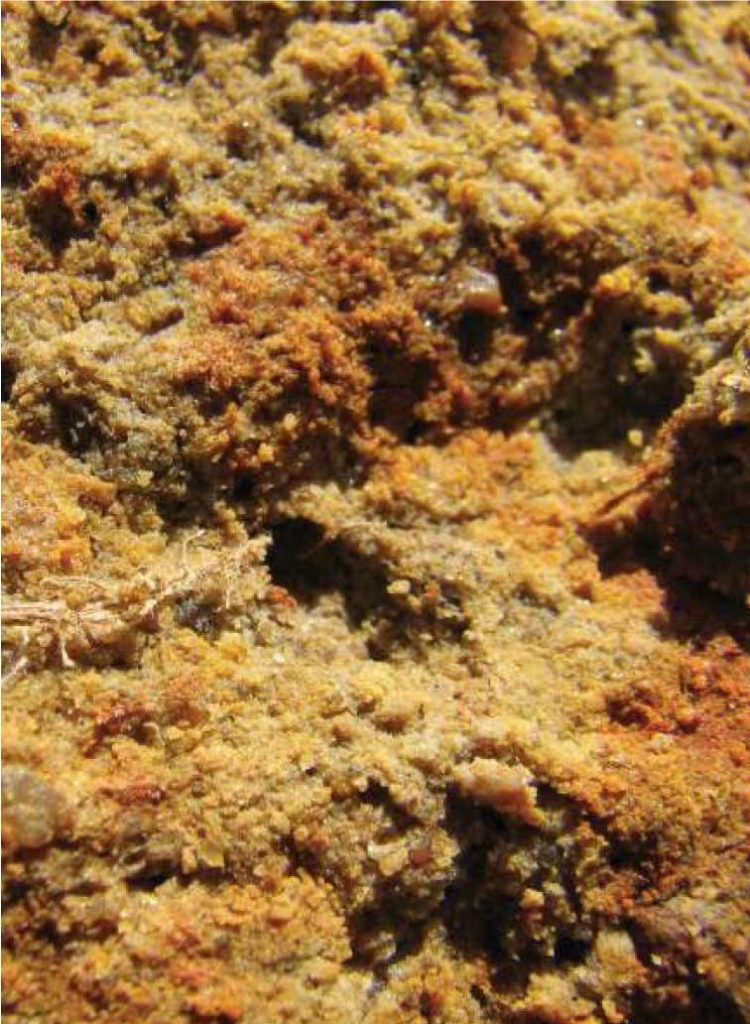
Soil type 9: Plintic soils
- Plintic soils occur in areas with a rainfall of more than about 450 mm per annum. They form under conditions of a fluctuating water table where the underlying material is semi-permeable for water. During the rainy season a temporary water table forms in the soil above the semi-permeable layer, which leads to reducing conditions. Later, it drains away, leading to oxidising conditions. These conditions lead to the movement of iron in the soil, which accumulates as yellow and/ or red and/or black flecks or nodules in this horizon (Figure 5). When specific dry periods occur between these cycles, it could harden to hard plintite (also known as oubank, ouklip or laterite) (Figure 6).
- The occurrence of plintite in the soil discloses the soil’s hydrology, where the varying water table is important for crop production. These soils have the ability to store the ground water effectively and later make it available to plants. However, hard plintite can be very hard and dense.
- When the plintic layer occurs at a depth of more than one metre, it is very useful for the cultivation of grain crops, due to its hydraulic properties. When it occurs close to the soil surface, (typically shallower than 400 mm) it poses a waterlogging threat, as the water table is close to the surface. Crops that are sensitive to waterlogging, should rather not be planted in plintic soils. Fruit trees and pecan nut trees must not be planted in soils with a plintic layer within 2 m.
- Hard plintite is very stable and is thus extremely sought after as road building material.
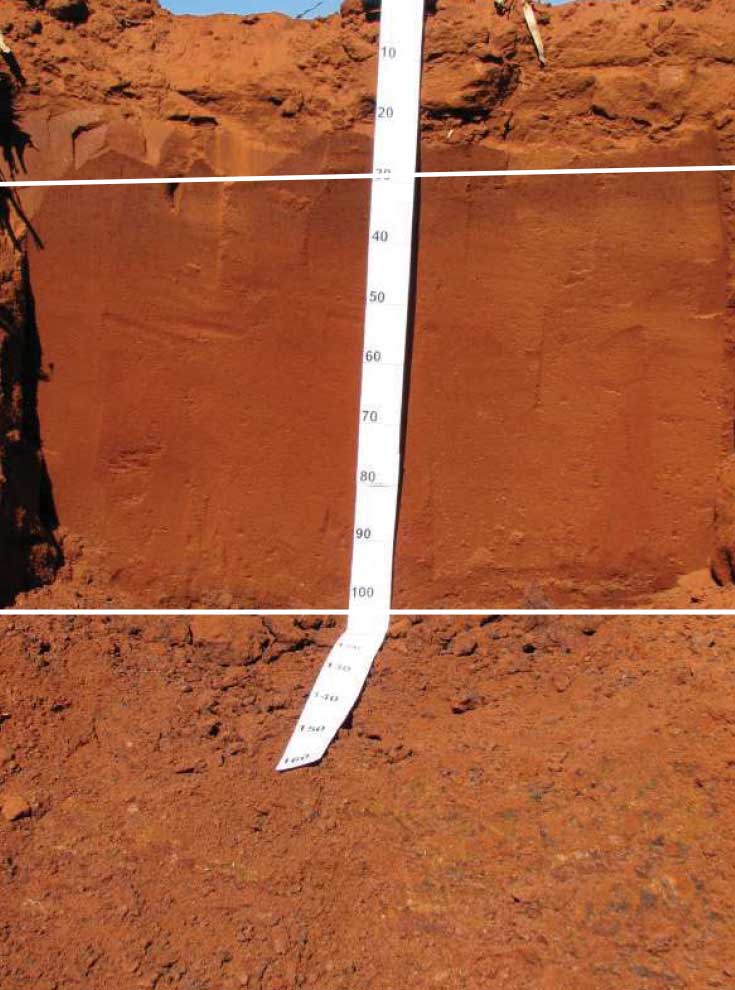
Summary
Under an orthic topsoil, a large variety of subsoil horizons may occur. The processes that drive the formation thereof have specific implications for soil usage. When these processes are better understood, the opportunities that the soil offers may be better utilised. The other side of the coin is that the threats they hold for specific usage, must be managed in order to reduce the impact thereof.
For further information, please contact the authors on:
Martiens du Plessis: 072 285 5414 / martiens@nwk.co.za
Prof Cornie van Huyssteen: 051 401 9247 / vhuystc@ufs.ac.za
In the next issue, the rest of the soil groups with an orthic topsoil will be discussed.
References
Fey, M. 2010. Soils of South Africa. Cambridge Uiversity Press, Cape Town, South Africa.
Soil Classification Working Group. 1991. Soil Classification – A taxonomic system for South Africa, Department of Agricultural Development, Pretoria.
Van Huyssteen, CW. Unpublished class notes for GKD214, University of the Free State, Bloemfontein.



